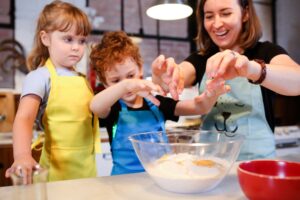Recipes! Do your children like to help in the kitchen? Who doesn’t! I have some fun and engaging no-prep activities to share with you! The recipe cards I have are so simple and functional! The activities can be used with almost any age and adapted to a variety of learning levels!
Following our recipe cards can encompass all learning styles! Visual learners, auditory, tactile, and kinesthetic learners will all love these cooking activities! The ultimate foundation of communication occurs through building language skills, and cooking activities can be such a fun and engaging way to work on these skills!
Cooking is an amazing time to work on communication skills! Cooking time can help our children learn new labels, practice new skills and have fun in the process! Just add your email for a free printable download with the strategies at the end of this blog post!
Here’s some examples of labeling items that you use while cooking:
- spoon
- chocolate chips
- butter
- tortilla
- salsa
- cheese
- pouring
- stirring
Looking to target specific skills? Following one-step directions like “Grab some napkins!” or “Get the cheese!” are perfect for practicing those one-step directions!
Remember you can change the level of complexity and ask children to follow 2 and 3-step directions which also helps with sequencing skills.
Spatial concepts may also be targeted! For example, “Put the cracker on the plate.” Also, “Put the cheese on top of the cracker.” These are easy to do when cooking!
This language-rich activity also facilitates the opportunity to improve receptive and expressive vocabulary! Think about all of the target nouns like plate, napkin, cracker, spoon, and more! Lots of action words will be used too! Think-open, close, count, place, eat, and more! Even present progressive verbs can be practiced while cooking! Think about words like opening, counting, eating and incorporate them into the steps.
Social questions are also a huge part of cooking! “Did you have fun helping today?” “What do you like better?” Through these questions, students have the opportunity to practice social skills, such as establishing and maintaining eye contact, and engaging in reciprocal conversation. Providing opportunities to help build students’ social language skills not only contributes toward their growth in communication, but also builds confidence in social situations!
When you finish your recipe, you can discuss each step completed to work on sequencing skills. This discussion also provides great opportunities to work on grammatical forms such as regular past-tense (-ed) and irregular past-tense to improve syntax skills!
Not only can you work on some of the specific skills I’ve listed, but this activity also offers an authentic opportunity to learn to generalize language and maintain skills! With all of this, you have to snag your free download today. Put it right on the fridge and make cooking a language enriched activity for your child!


0 Comments